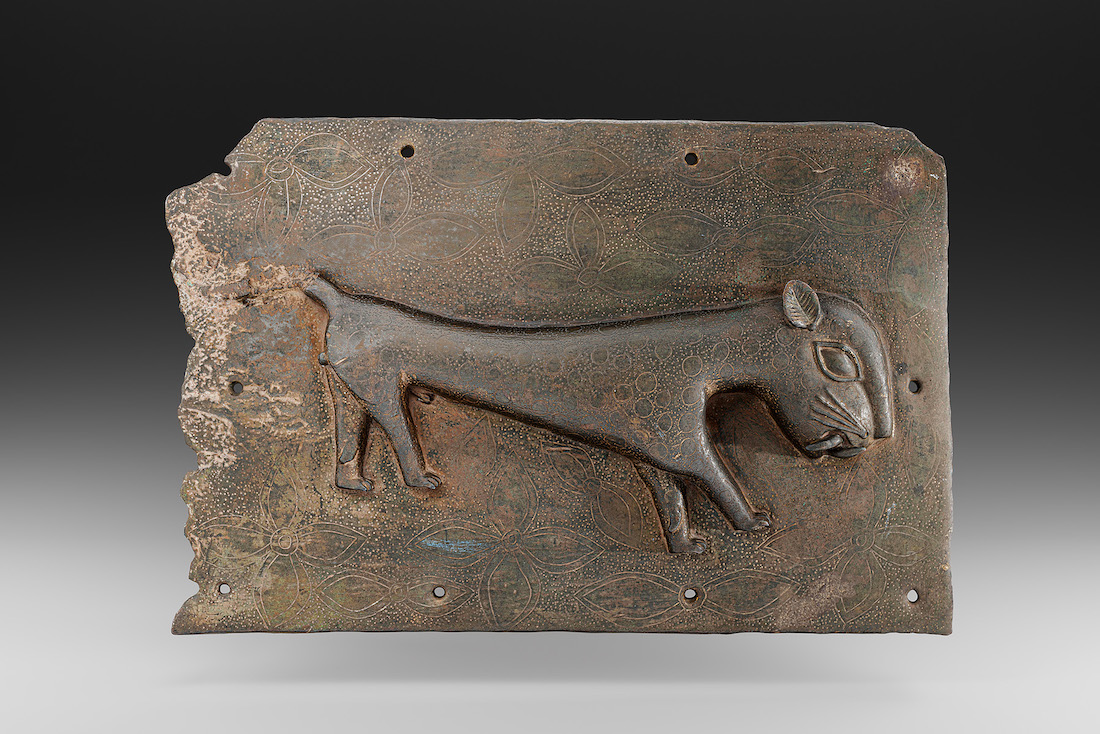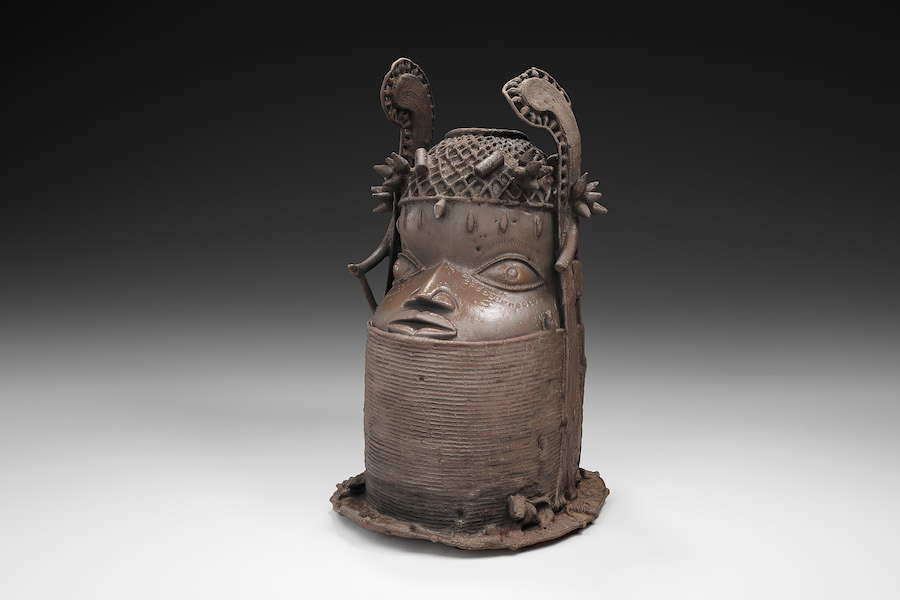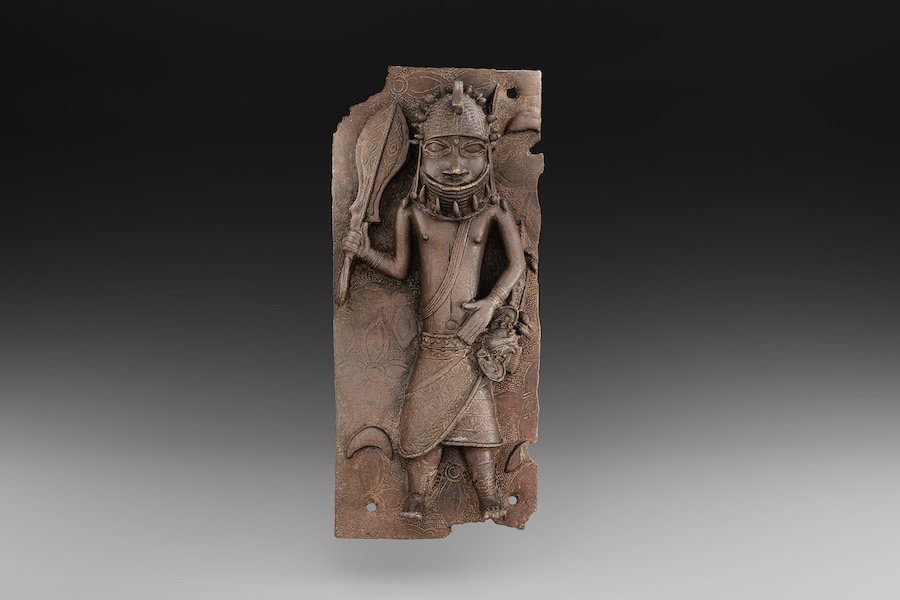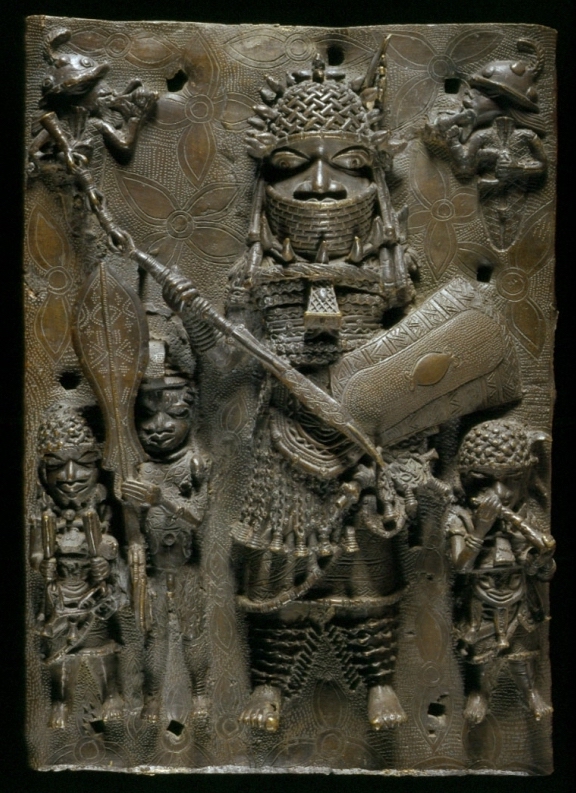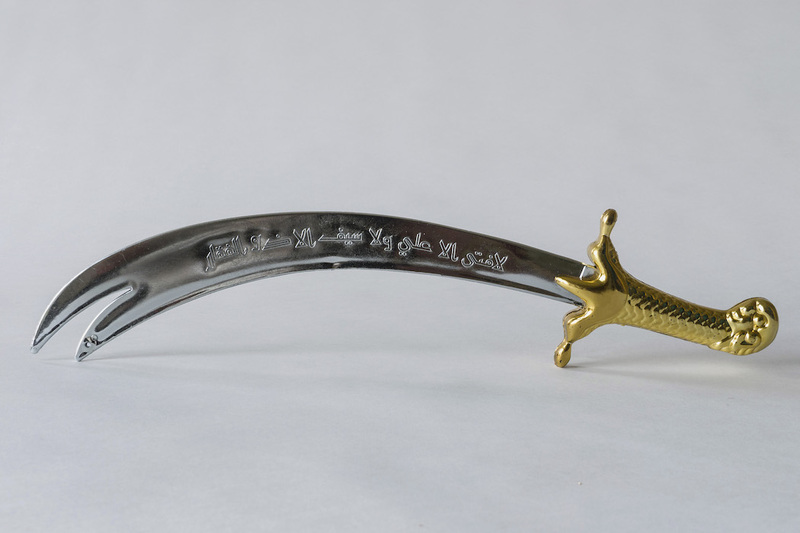
In his book The Brutish Museums: The Benin Bronzes, Colonial Violence and Cultural Restitution, anthropologist and curator of the Pitt Rivers Museum Dan Hicks explores the history of treasures stolen by the British from the Kingdom of Benin and kept in the collections of many museums around the world. Commenting on Hicks’ conclusions and claims, art historian Denis Stolyarov reflects on the prospects and problems of cultural restitution as a new nationalist project in the context of museum practice and global political processes.
Every December, the glossy contemporary art magazine Art Review publishes the Power 100 list: it includes people who, according to invited members of the art community, have the greatest social capital. Typically, the list is headed by successful gallery owners and museum directors from Western European capitals and New York, while the top ten includes fashionable artists at their peak. In 2019, editors gave two academics, economist Felwine Sarr and art historian Bénédicte Savoy, the sixth place ranking, and moved them up to third in 2020. Their significance stems from one joint project—a 2018 report, commissioned by French President Emmanuel Macron, on the need to return artifacts of African cultures to their homelands that are currently being kept in French museums and are there as a result of colonial plunder and exploitation.
The only thing that such ratings actually reflect is the worldview and value system of their compilers: party-goers, cultural journalists, and art critics. Over the last few years, the problem of colonial heritage in museum collections has become one of the most urgent issues on the agenda of the cultural establishment. The topic of restitution is becoming one of the hottest in museology. Significantly, this happens in the context of the simultaneous success of the Black Lives Matter movement, ranked by ArtReview editors as the #1 in the Power 100 list in 2020.
The Sarr-Savoy report was published in November 2018 in French and English on a dedicated website. The report has a very brief and dynamic backstory. In November 2017, Macron, then in power for six months, delivered a speech at the University of Ouagadougou in Burkina Faso, in which he called, among other things, to create conditions for the return of items of cultural heritage to Africa. In a column for Le Monde, published in January 2018, Bénédicte Savoy called this speech revolutionary—despite the fact that Macron’s proposal was rather modest in nature (it concerned not only permanent, but also temporary returns) and was placed in the context of the complicity of African curators in the smuggling of cultural artifacts. Savoy, who has dealt with restitution for most of her academic career, may well have already been working on the report at that time and felt an ideological turn in the minds of French politicians.
The report describes the role of colonial looting, smuggling, and deception in shaping European museum collections, most notably the Quai Branly Museum in Paris. The authors conclude with unequivocal recommendations on the need for a systematic, consistent, and unconditional return of African artifacts to their homeland. A concrete strategy with a specific time frame is suggested: the restitution process is divided into three phases and the first was to start immediately in November 2018. It is noted that laws that prevent restitution must be changed. It proposed the establishment of a “presumption of illegality” and to leave artifacts in European museum collections only if there is evidence that they were transferred with the absolutely free consent of the previous legal owners who were fully aware of what they were doing. Conflicts arising between countries receiving artifacts should be resolved by them independently by diplomatic means. The report notes that the absence or underdevelopment of the museum infrastructure cannot serve as a pretext for refusing restitution.
In January 2020, a new research project was announced, led by Bénédicte Savoy and Dan Hicks, dedicated to the origins of European ethnographic collections and the development of a methodology to determine the legitimacy of the ownership of certain objects. Dan Hicks is an archaeologist, an anthropologist, and a curator of the Pitt Rivers Museum, Oxford University’s Ethnographic Museum. In November 2020, he published The Brutish Museums: The Benin Bronzes, Colonial Violence and Cultural Restitution, in which he reproduces the structure of Sarr-Savoy’s report and arrives at the same conclusions regarding the so-called “Benin bronzes,” artifacts from the Kingdom of Benin (a city located on the territory of modern Nigeria), stolen by the British from the ransacked city during the military operation of 1897. Hicks is confident that they must be immediately returned to Nigeria—to the rebuilt Benin City. The Savoy-Sarr report lists the objects in the Quai Branly Museum and Hicks has compiled a list of museums that house Benin bronzes and other artifacts from the Kingdom of Benin: most of them are today in Berlin, London, and Oxford, but a significant number are distributed around the world. Around thirty Benin bronzes are in the collection of Kunstkamera, at the Museum of Ethnology and AnthropologyMuseum of Ethnology and AnthropologyIn his book Hicks erroneously states that they are located in the Russian Museum of Ethnography. in Saint Petersburg.
МАЭ № 595-20, МАЭ № 595-2, МАЭ № 595-8 / Peter the Great Museum of Anthropology and Ethnography (the Kunstkamera)
For British museums, future restitution looks like it may be more difficult than for the French ones: the British Museum’s collection contains about 200,000 artefacts from Africa, twice as many as in all of France. In both France and Britain, calls for restitution are received with hostility by the museum community. One of the most common arguments in favor of the impossibility of scholars’ proposals are laws prohibiting the removal of artifacts from museum collections. This did not prevent the French parliament from voting in favor of a new law in October 2020 to return twenty seven objects to Benin and Senegal, located mainly in the Museum on Quai Branly.
It is important to understand that the unfolding cultural debate concerns not just issues of ownership and legality of museum objects—it is a struggle between ideas about national cultures and the narratives that connect them. Opponents of restitutions perceive the calls of specialists for the return of artifacts as a threat to stories about complex multicultural relationships, in the center of which is a universal, predominantly Western European culture. Restitution advocates think the same way when it comes to multicultural relationships—and they fight against these narratives of predominantly Western European Culture, denouncing them as violent and colonial.
The former director of the Museum on Quai Branly, Stephane Martin, aphoristically called the Sarr-Savoy report “self-flagellation and repentance” and said that restitution contradicts the idea of an “objective” museum, turning it into an ideological tool. Hicks’ book fully confirms this latter idea, with the only difference being that it destroys the illusion of the possibility of the non-ideological existence of museums. His work is a concise historical confession and manifesto that describes the European museum as a key instrument of colonization, which remains so as long as stolen artifacts stay in it.
In June 2019, Tristram Hunt, the director of the Victoria and Albert Museum, the world’s largest museum of arts and crafts, wrote a column for The Observer in which he announced that decolonizing the collection would mean to decontextualize it. The return of artifacts will make it impossible “to position objects beyond particular cultural or ethnic identities, curate them within a broader intellectual or aesthetic lineage, and situate them within a wider, richer framework of relationships.” Ultimately, this process will destroy the idea of an “encyclopaedic museum.” Hunt is convinced that “universal” museums have not exhausted themselves; they protect culture from the narrowness of national boundaries. Instead of destroying them, it is necessary to create new “universal” museums in countries where they do not exist. Hunt writes a classic manifesto of multiculturalism, opposing Macron and, unexpectedly, a fictional Marvel character Erik Killmonger. Killmonger, the supervillain in the Black Panther movie and comic books, steals an axe from the fictional “Museum of Great Britain” that is originally from the fictional African country of Wakanda, justifying his actions with the logic of restitution, and embodies, according to Hunt, “current controversies over museum collections and colonial injustice.” Hunt argues with activists, representing them, according to the curator of the Horniman Anthropological Museum Joanna Zetterstorm Sharp, as comic book characters: irrational, emotional, and aggressive members of the diaspora.
Hicks, like Savoy and Sarr before him, suggests abandoning the idea of multicultural and universal museum, himself resorting to the universal principles of justice and the rejection of the violence that is evidenced by museums displaying spoils of war. The entire depth of the political and academic potential of Hicks’optics is not immediately obvious, since it is formulated primarily through the critique of the tradition and the current state of anthropological museums. In his book, Hicks denies the possibility of recontextualizing museum collections, an idea that has become the standard of museum curating in recent decades. It is no longer enough to rewrite museum labels and to accompany artifacts with a reference into the problematic history of their inclusion in the collection. Violence with reservations is still violence.
Victoria and Albert Museum
According to Hicks, the museum exhibits in question came to these institutions as a result of deliberate policies and planned campaigns, framed as the struggle of the universal civilization against barbarism. In reality, colonial plunder was one of the major ways to destroy sovereignty and create an aura of one’s own superiority. The museum was and remains an element of this strategy, the frontier of an empire, demonstrating its successes. Historical events are recorded in the museum, stretched out in time for an indefinite period and, in principle, cannot become a thing of the past. The museum, as Hicks puts it, reproduces the act of violence over and over again—each morning, [when] the lights [are] switched on, the doors [are] opened to the public.” The idea of a “universal museum” is a screen designed to suppress the trauma of colonial looting and to preserve silence about the violence. Hicks’ book and the subsequent necessary restitution is becoming a therapeutic way to overcome this trauma, an attempt, through confession and atonement, to complete the act of violence and move on to the next stage—healing. And this is the main paradox of the book, which in its ambitions goes much further than restoring justice in favor of the victims: it allows the culture-aggressor to talk about its history again, without resorting to silences that deprive it of its consistency.
Hicks’ book is profoundly nationalist in nature: it resurrects the genre of national history at a time when it seemed that it was no longer capable of producing academically valuable narratives. Hicks reconstructs history in great detail, combining well-known chronology with data from unexpected sources, such as military medals, for which he reconstructs military operations that are not recorded in the media or in chronicles. Hicks describes the mechanics of corporate-national imperialism, retracing the course of events month by month. The culmination of his research and practical conclusion is the formation of the collection of the museum in which he works as a curator.
The history as a whole is told exclusively from the British position, the victims of colonialism play the role of passive victims even in the moments of the most active struggle. A striking example is the story of the confrontation between the British vice-consul Harry Johnston and King Jaja of OpoboOpoboA city in Nigeria. The traditional city-state was founded in 1869 by ex-slaves from Bonny, another state that was the main exporter of slaves to West Africa in the 19th century., deceived by Johnson in 1887, captured and sent into exile. Subjectivity is demonstrated on a grammatical level. Johnston is the protagonist of this story: he is an alumnus of King’s College London, studied painting at the Royal Academy, led an expedition to Kilimanjaro. King Jaja “was taken as a slave,” and later, as if by himself, “went on to become” an influential merchant, founding Opobo during this time, and in the end was “deceived” by the British, imprisoned and exiled to the Caribbean. Jaja is a helpless victim who, despite all his talents, could not resist the cunningness and meanness of the Britons. Hicks repents for this before the reader. The transformation of the most influential merchant and politician into a toy of fate is not just a textual accident, but the political position of the author. The museum curator becomes the agent of history and takes responsibility for the national crimes committed by his predecessors—British politicians and merchants.
Refusing to appeal to the extinct myth of national greatness, the nation regains its voice through shame and repentance for all those terrible crimes committed by it. National history, successfully blown up by critique from the left through working class history, feminist optics, cultural anthropology, queer theory, etc., is suddenly reborn from the ashes. The decolonial project turns out to be not a breakdown of the logic of the colonial project, but its evolutionary stage, creating an opportunity to speak about one’s heritage again. Foreign national heritage—the Benin bronzes—are not only no longer needed for the formulation of the national idea, but they interfere—and their future return to their homeland is felt not as a cultural sacrifice, but as a liberation.
Right: Plaque with the image of the King and his servants. Benin Palace, 1550–1680
1977.187.36, 1978.412.309 / The Metropolitan Museum of Art
In this context, it becomes clear why at the current historical stage it was Macron of all European leaders who first spoke about restitution. This is due to the peculiarity of the modern French national project. Speaking at the University of Ouagadougou, Macron indicated that he speaks on behalf of France with Africa, or rather with the fifty four countries that make up it. The key subjects of the negotiations are countries and their nations that possess national cultural heritage that is unfairly located in Europe. The global world is fragmented into separate countries, and in contrast to this, societies within each country turn out to be static in their unity. Macron urged his African listeners to adhere to “universal” values: the list included women’s emancipation, the reduction of migration, the rejection of any forms of religious fundamentalism. In France itself, he also seeks to create a homogeneous society built on universal “republican” values. The main enemy of these values is separatism, primarily “Islamist separatism” coming from outside of the country.
In this light, the program of restitution of cultural artifacts begins to look like a tool to strengthen national sovereignty—and a way to cleanse its own French national project from the legacy of colonial violence, the crime of which for Macron is an element of a personal and generational identity. Repentance is formalized as an application for cultural and ethical leadership in Europe and the foundation of a global francophone project. Restitution is not just a claim for universal justice, but the strengthening of the national idea at the moment when old narratives have clearly stopped working. At the same time, the classical opposition between civilization and barbarism is reproduced, in this case—the barbarism of encyclopaedic museums. Preserving the universal museum in its present form is no longer appropriate.
More amorphous British nationalism is built on the simultaneous coexistence of various under-formed ideologies, which makes it more flexible and often more humane in relation to various forms of manifestation of otherness. For British politicians, huge, wealthy museums are the backbone of a pluralistic cultural policy that puts Hicks in opposition to the establishment. Any successful precedent for the return of museum artifacts threatens to open the Pandora’s Box and exacerbate internal European conflicts, such as the issue of the marble sculptures and reliefs of the Parthenon in the British Museum.
Hicks is not a politician, but a scholar and an activist, and works in a relatively small anthropological museum. His position is the only way to maintain professional integrity. He can no longer deal with the processing of stories about cultural relationships, justifying the retention of looted things in the museum collection. Despite the willingness of contemporary museums to speak critically about their history, the preservation of colonial collections looks like an internal contradiction. Restitution is a way of finalizing curatorial narratives in which the museum itself is placed at the center of the plot. Returning the artifacts to their homeland will not deprive the curator of a job, but will complete the still unfinished narratives of the acquisition of these objects. Hicks views his role as a researcher of stories, trauma, and loss, but not objects themselves.
It is significant that Hicks almost does not articulate who his partners and allies are on the other side. In various places, he talks about the Nigerian government, about the Nigerian parliament, about Nigerians as a nation, about the diasporas, about Ewuare II—the Oba, ceremonial leader of the Edo people. For him, this is secondary, because the issue of restitutions interests him primarily as an academic and a representative of one of the British museums and not as an ideologist of a new cultural geopolitics. The image of the recipients of cultural heritage is becoming abstract, and therefore restitution has the potential to become part of other projects, most notably pan-African nationalism and the Black Lives Matter movement.
Hicks is a political activist and makes significant efforts to advance his agenda. He often speaks publicly, actively maintains his Twitter account (where he has almost 30,000 subscribers) and collaborates with other academics and activists. One of the most popular supporters of Hicks is the American rapper MC Hammer (Stanley Kirk Burrell), with whom they hosted a book presentation and an hours-long public discussion on Clubhouse. During this discussion, MC Hammer, who was born and lives in California, indicated that for him the question of the Benin bronzes is about his own identity, he perceives them as his own heritage: “We know you have our stolen history. But you are trying to figure out a narrative to justify retaining them—and you are causing a fight. It’s time to return it.” Africa is recognized as a common homeland for millions of people whose ancestors were enslaved and forcibly brought to America. Hicks’ position is the progressive position of a negotiator on the part of white Europeans, capable of beginning to resolve ages-old racial conflicts by abandoning claims to cultural hegemony. The differences between the real countries of Africa and the political forces within individual countries cease to be significant, since Africa is becoming a symbol of internal European and American politics. The issue of restitution turns out to be embedded in another global political project, within the framework of which the issue of pan-African sovereignty turns out to be an instrument of struggle against the system of white supremacy not only at the international level, but also within Western societies.
Right: Head of the King. The Kingdom of Benin, 18–19th centuries
III C 7657, III C 10467 / Ethnologisches Museum der Staatlichen Museen zu Berlin, Martin Franken
As an epilogue, it is worth mentioning that the main weakness of the decolonial project promoted by Hicks, Sarr, and Savoy is its reliance on the classical national model of global politics. They offer mechanics for overcoming trauma and rethinking historical heritage based on national projects, but do not offer an alternative to the national model itself. On the one hand, this allows them to talk with politicians in a language understandable to those, but on the other hand, it limits the political potential of restitution to forms acceptable to global capitalism and does not offer any form of alternative locality. Their decolonized museum creates a subject with a static identity who has lived through their trauma, a universal consumer of digital culture and a producer of data.
Contemporary imperialism has much in common with the models described by Hicks: global corporations are at the forefront of this process, with nation states supporting them. Trading corporations of the 19th century “developed” “new” lands, constructed economic and cultural hierarchies on their territories. Subordinate peoples were exploited for resources and their exotic cultures; the metropolis remained the center and the source of power and supremacy. Modern international digital corporations are occupying territories in the same way, including more and more new markets in the zone of their monopolies. The basis of contemporary international cultural policy is not merely hierarchy, but atomisation—and modern museums are becoming a similar instrument for capturing new territories as before, but in a new format of the production of static cultural identities, ready for consumption and production of content that merges into Big Data, which becomes a key global resource.
International corporations that carry out the classical colonial development of the world in new supranational forms become allies of the new cultural program of decolonization, which understands coloniality conservatively. Their task is to transcend national borders and de-escalate international cultural contradictions in order to optimise their economic models. They are ready to facilitate the movement of objects, capital, and labor around the world—along with their own influence and control over the flows of information. In this policy, the museum serves as an infrastructural unit that does not go beyond the logic of state borders. It forms a stable progressive national identity that plays the role of a universal cultural platform for unified labor and consumption patterns imposed by global companies on their users.
Nevertheless, it is possible to start thinking about it later, when the looted artefacts are returned. Their retention in the collections of European and American museums facilitates the work of the curators of these institutions, but ideologically ceases to have any meaning, except for the maintenance of long-obsolete myths.
P. S. After this text was written, Hartmut Dorgerloh, the director of the giant new Berlin museum centre Forum Humboldt, announced that the world’s largest collection of Benin bronzes from the Ethnological Museum Berlin, part of the Forum, should be returned to Nigeria. That does not mean their immediate restitution, as this decision still has to be confirmed by the Board of Trustees of the Prussian Cultural Heritage Foundation as well as several ministries, but there is little doubt that they will be returned in the foreseeable future.
